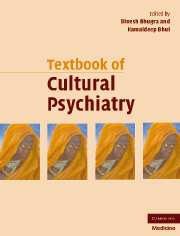Book contents
- Frontmatter
- Contents
- Contributors
- Foreword
- Preface
- Part I Theoretical background
- Part II Culture and mental health
- Part III Culture and mental disorders
- Part IV Theoretical aspects of management
- Part V Management with special groups
- 35 Intellectual disabilities across cultures
- 36 Child psychiatry across cultures
- 37 Management of sexual dysfunction across cultures
- 38 Refugees and mental health
- 39 Working with elderly persons across cultures
- 40 Working in liaison psychiatry
- Part VI Cultural research and training
- Cultural psychiatry: the past and the future
- Index
- References
37 - Management of sexual dysfunction across cultures
from Part V - Management with special groups
Published online by Cambridge University Press: 11 August 2009
- Frontmatter
- Contents
- Contributors
- Foreword
- Preface
- Part I Theoretical background
- Part II Culture and mental health
- Part III Culture and mental disorders
- Part IV Theoretical aspects of management
- Part V Management with special groups
- 35 Intellectual disabilities across cultures
- 36 Child psychiatry across cultures
- 37 Management of sexual dysfunction across cultures
- 38 Refugees and mental health
- 39 Working with elderly persons across cultures
- 40 Working in liaison psychiatry
- Part VI Cultural research and training
- Cultural psychiatry: the past and the future
- Index
- References
Summary
EDITORS' INTRODUCTION
The management of patients from different cultures, especially if the therapist is from another culture, raises interesting questions about the role of perceived and real power embedded in the therapist. Furthermore, the perceptions and expectations of the therapeutic encounter and functions of therapy have to be taken into account. Recognition and understanding of social and cultural factors and their inherent complexities are a useful first step in building blocks of therapeutic alliance between couples and therapists. While individual therapy and couple therapy have many common principles and overlaps, couple therapy brings with it at least two sets of clear expectations (others' expectations, e.g. children's, may be hiding behind the couple) and challenges. Knowing a couple's type of marriage may allow the therapist to explore potential therapeutic obstacles. Satisfaction with marriage is related to the type of marriage.
Bhugra and de Silva in this chapter put forward some strategies in assessment and management of sexual dysfunction. The gender roles and gender-role expectations, particularly the role of women in patriarchal societies, may make it difficult for a couple to accept psychological therapies. Culturally influenced components of therapies may not easily be acceptable to all individuals, especially if their cultures differ from those where these therapies have been developed. The nature of mixed-race couples has to be addressed differently. Specific groups may indeed require specific intervention. They argue that ethnicity and personality of the partner, along with the couple's willingness to communicate on other unrelated issues, will allow the therapist to deal with and potentially to reduce conflict and increase satisfaction within the relationship.
- Type
- Chapter
- Information
- Textbook of Cultural Psychiatry , pp. 484 - 502Publisher: Cambridge University PressPrint publication year: 2007



